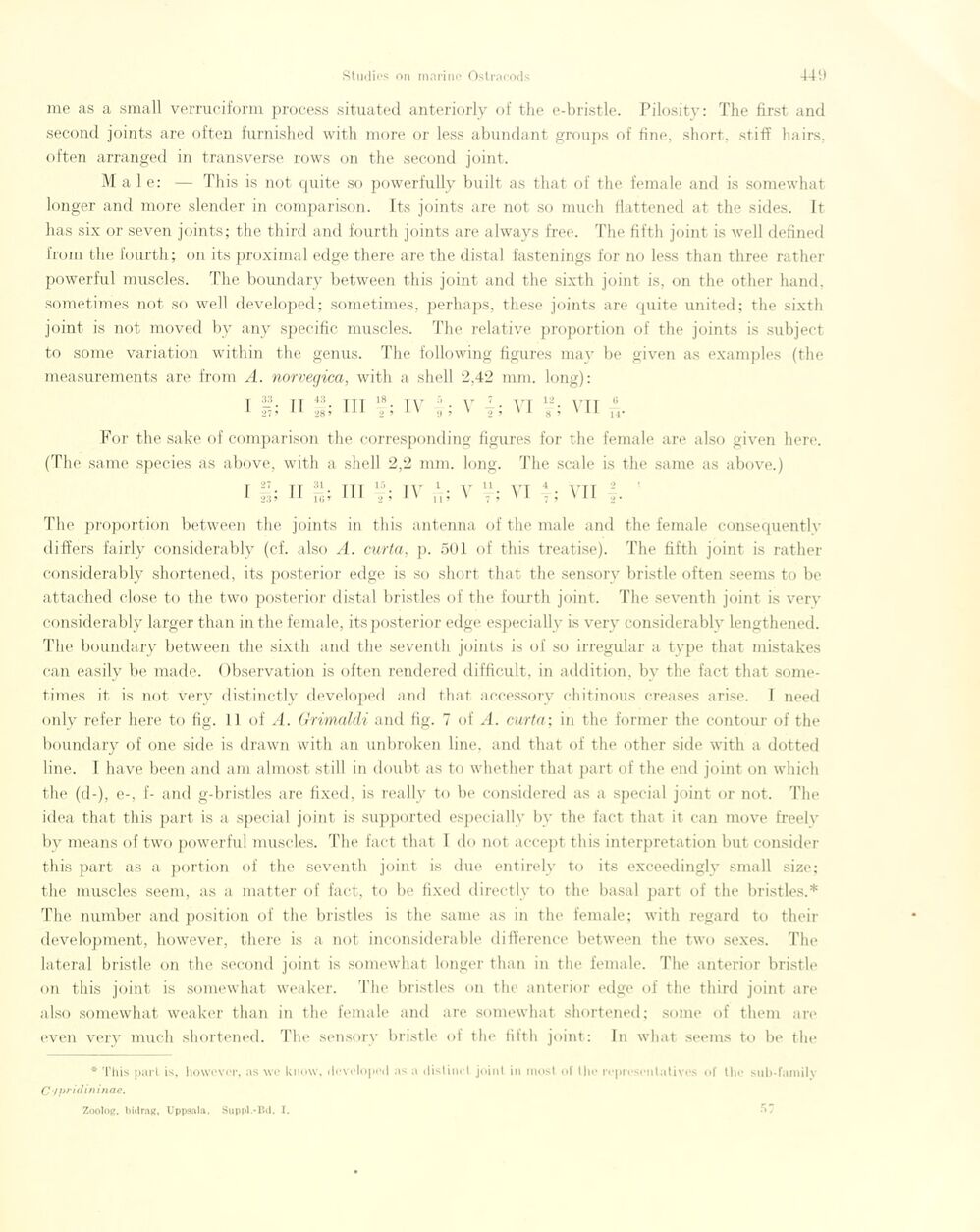
Full resolution (JPEG) - On this page / på denna sida - Sidor ...

<< prev. page << föreg. sida << >> nästa sida >> next page >>
Below is the raw OCR text
from the above scanned image.
Do you see an error? Proofread the page now!
Här nedan syns maskintolkade texten från faksimilbilden ovan.
Ser du något fel? Korrekturläs sidan nu!
This page has never been proofread. / Denna sida har aldrig korrekturlästs.
me as a small verruciform process situated anteriorly of the e-bristle. Pilosity: The first and
second joints are often furnished with more or less abundant groups of fine, short, stiff hairs,
often arranged in transverse rows on the second joint.
M ale: — This is not quite so powerfully built as that of the female and is somewhat
longer and more slender in comparison. Its joints are not so mueh flattened at the sides. It
has six or seven joints; the third and fourth joints are always free. The fifth joint is well défi ned
from the fourth; on its proximal edge there are the distal fastenings for no less than three rather
powerful muscles. The boundary between this joint and the sixth joint is, on the other hand.
sometimes not so well developed; sometimes, perhaps, these joints are quite united; the sixth
joint is not moved by any specific muscles. The relative proportion of the joints is subject
to some variation within the genus. The folio wing figures may be given as examples (the
measurements are from A. norvegica, with a shell 2,42 mm. long):
I U; H
ITT
18
IV
V
VI
VIT
For the sake of comparison the corresponding figures for the female are also given here.
(The same species as above, with a shell 2,2 mm. long. The scale is the same as above.)
-7. il i1, m
23 ? 11 1 <; r 1 11
IV
V V; VI
VII
The proportion between the joints in this antenna of the male and the female consequentlv
differs fairly considerably (cf. also A. curta, p. 501 of this treatise). The fifth joint is rather
considerably shortened, its posterior edge is so short that the sensory bristle often seems to be
attached close to the two posterior distal bristles of the fourth joint. The seventh joint is very
considerably larger than in the female, its posterior edge especially is very considerably lengthened.
The boundary between the sixth and the seventh joints is of so irregulär a type that mistakes
can easily be made. Observation is often rendered difficult, in addition, by the faet that
sometimes it is not very distinetly developed and that accessory chitinous creases arise. I need
only refer here to fig. 11 of A. Grimaldi and fig. 7 of A. curta; in the former the contour of the
boundary of one side is drawn with an unbroken line, and that of the other side with a dotted
line. I have been and am almost still in doubt as to whether that part of the end joint on which
the (d-), e-, f- and g-bristles are fixed, is really to be considered as a special joint or not. The
idea that this part is a special joint is supported especially by the faet that it can move freelv
by means of two powerful muscles. The faet that T do not accept this interpretation but consider
tilis part as a portion of the seventh joint is due entirely to its exceedingly small size;
the muscles seem, as a matter of faet, to be fixed directly to the basal part of the bristles.*
The number and position of the bristles is the same as in the female; with regard to their
development, however, there is a not inconsiderable difference between the two sexes. The
lateral bristle on the second joint is somewhat longer than in the female. The anterior bristle
on this joint is somewhat weaker. The bristles on the anterior edge of the third joint are
also somewhat weaker than in the female and are somewhat shortened; some of them are
even very much shortened. The sensory bristle of the fifth joint: In what seems to be the
* This pari is, however, as we kuow, developed as a dislinet joint in most of the representatives of the sub-Familv
C/pridininae.
Zoolog, tudrng, Uppaala. Suppl.-Bd, I, a"
<< prev. page << föreg. sida << >> nästa sida >> next page >>